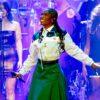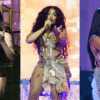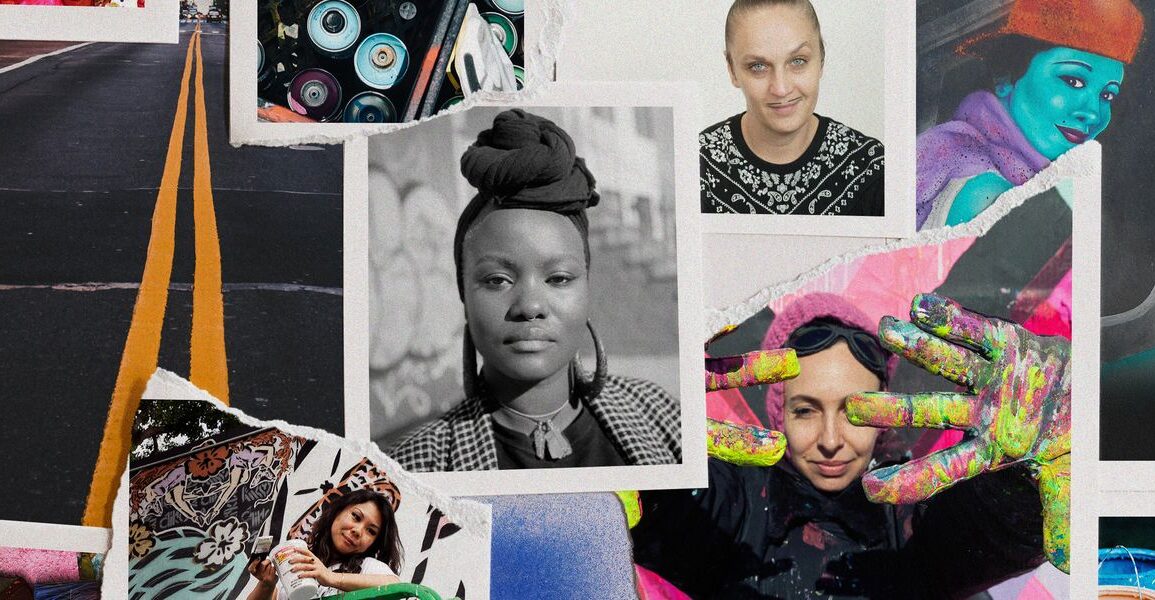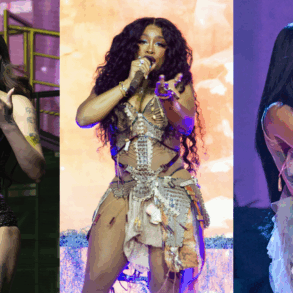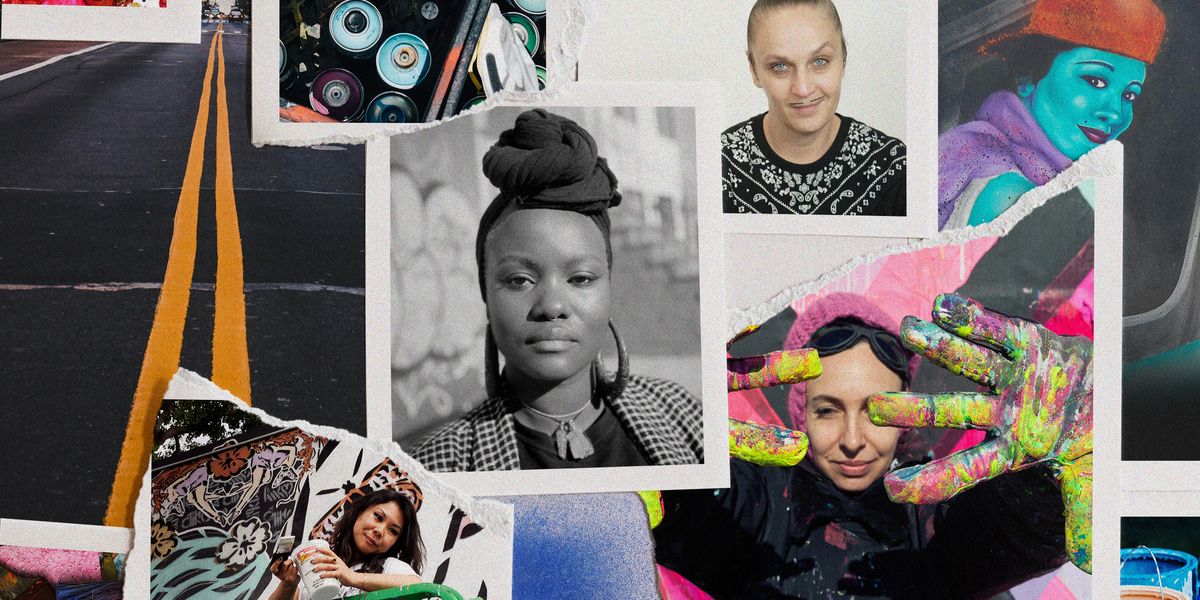
Street art. It’s more than just graffiti. Think of the large murals you pass on a daily basis that turn outdoor spaces into airy galleries and transform the vibe of neighborhoods. It’s a medium that’s been used by some of the most celebrated artists of our generation — Banksy, Jean-Michel Basquiat, Keith Haring — and one that continues to produce talents through the modern art movements of today.
But as you might have noticed from the above list, given the medium’s roots in graffiti (an often illegal and physically taxing form of creation), street art luminaries often tend to skew male. That doesn’t mean, however, that there aren’t some incredible women out there whose art isn’t just eye-popping — it also has something to say. Which is why this month we’re presenting five of our favorite female street artists. From every corner of the world, these are the large-scale creators who infuse ordinary walls with a sense of wonder.
Kashink
Maëva Martinez, or Kashink as she’s known professionally, is obsessed with evolution. As a muralist, they paint eye-popping walls that feature figures with multiple eyes, indeterminate genders, and implied backstories that range between tragic and comedic. However, those same figures have recently been making their way into real-life, makeup-layered faces, and even make an appearance in Kashink’s debut music video, their first foray into the medium. To hear her explain it, street art may be an interest, but communication and creativity is a passion.
“I think it’s just interesting for me to consider myself a performative artist instead of just a street artist,” she says. “When I started graffiti, I was, like, really angry: ‘I want to take over the space!’ Now I’m feeling more and more like I’ve been there and done that. I’ve worked so hard physically. It takes a lot of effort. Now is this other time in my life where I want to be more at peace with the same energy.”
On the recurring theme of masks in their work:
“The tradition of masks exists everywhere in the world. I think sometimes in Western culture, we see masks as something that hides, something negative. To me, it’s actually quite the opposite. You can actually wear a mask and reveal yourself, and makeup is one of the examples. It’s a great sign that one is adaptable and can live a life in different fields, like family or work. I was obsessed with portraits and faces, and I wanted to create something that I had never seen before. When I started painting, it was 2000 in Paris, and there were huge billboards in metro stations. I would see really huge billboards with bodies of women looking amazing and flawless. I found it very disturbing as a young adult to be bombarded with these images every day, and I thought that it would be really important to paint something else. I found it so cruel to realize that it was some sort of propaganda … for women to feel like s–t all the time. It was denying the diversity and reality of how bodies are made. I felt like, ‘All right, then … I’m going to paint something that’s definitely not this aesthetic.’ I wanted to create something that was imaginary. So, I came up with these really bright colors and four eyes.”
Why she embraces fluidity in creative expression:
“Being a 3D artist, or being a musician, or writing a book, or wearing this makeup to me is also the same practice. It’s just different aspects of the same thing. I like this idea that in you, our identity, we’re not only one thing — we’re not only the children of our parents, or sister, or the person who works in a certain job. We’re all of that, and that’s what makes us complex and sometimes a paradox. But all together, it makes us who we are.”
On their trademark paint mustache:
“I consider it almost like a piece of public art. It’s been almost 10 years since I’ve been drawing these two lines on my face every single day. Why do we have these exotic codes for makeup? Why are two symmetrical lines okay on someone’s eyebrows or as eyeliner, but not above the lip? Because it’s the same lines! Why do we have to be acceptable all the time? I found it super-interesting to question that. And then of course, I was also interested in all the gender norms, questioning why women shouldn’t have mustaches. It also underlines something that we tend to try to hide. Every woman has a secret mustache. In the last decade since I’ve been doing this, feminism has become a thing. Queer culture and [questions around] gender normativity has become important. I never thought I was going to make a living off my art. And I never thought I was going to travel so much and do so much, and I’m super-grateful.”
Lady Aiko
Lady Aiko’s art is born from a place of adventure. After all, as a young woman, she came to the United States without a grasp of English and with a dream to make friends and make art. (Both of which she succeeded in doing.) And since then, she’s had a string of notable successes, including collaborating with Banksy, designing for Louis Vuitton, and perhaps her current favorite, running workshops for teenagers and attending art festivals around the world.
But there was a definitive moment that still sticks out in her mind, highlighting her dedication to crafting a feminist-friendly playing field: being selected to paint the mural at Houston Street and the Bowery, a location made famous in the early 1980s by another street art hero.
“The wall was painted by Keith Haring in 1982,” she recalls. “Around 2008, [art dealer] Jeffrey Deitch started curating a new generation of artists to paint the wall. Over the years, four artists would paint every season, and it took five years to have women paint the wall. I was hoping someday I could paint this wall, and in 2012 I finally got the invitation. It took five weeks, and it was spray-painted by all women. I didn’t ask any males for help. People were like, ‘Girls are painting! That’s so cool!’”
On exploring Japanese iconography in her work:
“I left the country as a young girl. I was craving pizza and hamburgers. I grew up in the middle of Tokyo. I grew up with this Japanese pop culture and Japanese traditional art. The more I started traveling in other countries, the more I started to discover that Japanese culture is really cool. It’s so unique. And I should start talking about my heritage instead of being humble following traditional graffiti and street art. I felt positivity when I worked with my heritage by using a mix of photography and street art. We also have similar working-class art. It started in the 15th century — working-class art stuff that kind of reminds me of hip-hop.”
On choosing the rabbit as her personal symbol:
“I was born in the Year of the Rabbit in Chinese astrology. So, it’s my symbol. At the beginning, I was spray-painting with boys, and they all had their own icon. And I got the inspiration to have my own. So ever since then, I bring my stencil and spray-paint this bunny. I definitely felt like boys and girls were different at the time. I had a lot of issues with boys, so I had a really miserable time. Because I just wanted to paint like boys paint. My physical body doesn’t need to do that. And I realized that I can’t, like my body is different. I work differently. I think everyone has this type of story. Doing something by yourself. Speaking of your own happiness. So, in 2005 I cut this stencil in Banksy’s studio. And when I carry this stencil and spray-paint it pink, it reminds me who I am and makes me happy.”
What’s next:
“I have nearly 20 years of experience now. And what I’m going to do next is give my experience to the next generation. I met kids last week in Sarajevo. I don’t have to worry about how to survive and leave the country and go to the next place. They would say, ‘Aiko, I’m so inspired by your life and leaving your country with just a suitcase.’ It can change, but also you guys can do this. You can change your identity by making art or just traveling around getting inspiration. So, I’m quite confident about sharing my experience with a younger generation. I am also learning a lot from them, new technology and new ideas. I feel we are helping each other. Auntie Aiko needs help!”
Yuzly
Yuzly wants you to love yourself. The artist (born Ingrid Yuzly Mathurin) scatters personal imagery, hip-hop iconography, floral motifs (a nod to her grandfather), colors inspired by the Yoruba heritage of her Haitian roots, and — above all — strong Black women through her work. The way she sees it, through art she’s sharing a piece of herself. Why hide from that?
“I think that’s important,” she says. “I’m telling a little bit of my story, a piece of who I am, in hopes of it’s helping someone else with whatever they’re going through.”
On making art around physical limitations:
“I did a wall in Los Angeles out at an elementary school, and this was actually the beginning of me finding out I’m having a new disability — which is arthritis. To actually paint, it was quite challenging, but I got it done. It was just weird because it was my first time actually experiencing needing help because of my new disability. It was quite alarming to see how people looked at me differently when you’re asking for more, and they didn’t want to give you more because you look normal. I’m able to maneuver a lot better now. But I feel bad for anyone who’s an artist who’s disabled. The challenges that they go through in different spaces, especially with doing your work. It’s very hard work. And it’s really important that the team who’s hiring you, that they actually are very supportive and making sure that you’re safe while you’re creating the work.”
On art as education:
“I’m painting Martin Luther King and Malcolm X. So, I’m really excited. It will be a mural collaboration I’m doing with another artist. But it’s going to be at 606 Lexington Avenue in Brooklyn, New York. The gentleman who owns the building in the neighborhood is very specific on what he wanted. So, me and this other artist, we’re combining our styles to create something where it’s still figurative. It’s really nice when I’m able to paint historic Black figures because it’s teaching the youth about our past history. Kids, they don’t really know about that, which is my favorite part of doing street art and public art.”
How she created an Atlanta landmark:
“I was so excited to work with Living Walls. What they do is they help to take BIPOC artists, and they teach them how to navigate and build a mural career. They called me up one day and were like, ‘Hey, we would love to have you do a project with Adult Swim.’ I was so ecstatic. They told me I have free range to do whatever I want. It was during a pandemic, and it was also the time of Black Lives Matter. The protests are happening, and hate crimes are going against the Asian community. And so, that was my head. When I create work, it has a lot to do with what’s happening around me. My foster mom actually grew up in Japan in high school. And so, that’s something a lot of people didn’t know about. So, I decided to paint a portrait of a woman who was mixed, with Asian and Black cultures with a big Afro. She’s holding a pick in her hand, wearing Adidas sneakers, because I’m a sneakerhead. And she’s just proud. She’s rocking her fro, and she’s wearing a beautiful kimono that I designed.”
Lady Pink
Lady Pink first got into the world of street art as a pure act of rebellion. (“Jumping out the window and going to the worst neighborhoods in New York,” she recalls.) However, what was once an act of youthful acting out led her to places she’d never expected, including rubbing elbows with the cultural and artistic elite and even a role in the 1983 hip-hop film Wild Style.
“They kept telling us that the art world is very fickle,” she says. “And fads change, and moods change. We’re selling our paintings like hotcakes in the early ’80s. And running in circles with, like, Keith Haring and Basquiat. I even had a conversation and met Andy Warhol when I was 17. So, we were going to parties and rich people’s houses and traveling the world, and there’s movie releases and premieres, and we’re being treated like celebrities as teenagers. But you know, it never stopped. … They were showering us with liquor and drugs and freebies, being treated like a celebrity, signing autographs at the age of 16. I mean, it was ridiculous.”
While the shiny trappings of her career aren’t quite as much of an interest these days (she’s since moved out of New York City due to law enforcement search and seizures of painting supplies), Lady Pink’s work still holds a place of esteem in the street art world, along with the spots on the walls of the Metropolitan Museum of Art, the Whitney Museum of American Art, and the Brooklyn Museum.
On repping for women at an early age:
“At the age of 15, my very first boyfriend was arrested and sent to live with family in Puerto Rico. His friends took me under their wing and taught me the correct way of tagging. Because it takes a long time to study the correct style before you can bring it out. It isn’t random letters. It’s all very specific to an era and to an area. It took me months to convince them to take me to the train yards, because it is a rough kind of business. It’s very labor-intensive manual labor in the dead of night. And harsh conditions. It’s mostly the kind of stuff that guys like to do. Like playing cops and robbers, cowboys and Indians, and playing war games. They’re made for this. Girls are not trained for that as much. Also, I dressed femme, with dresses and all of that. But underneath, I was a tomboy, able to hold my own, carry my own bag of paint, scale big walls and fences, and go through all those harsh conditions with grace and dignity. I had to keep my head up, and because all the other girls at school were looking up to me not to fail. They knew I was a strong feminist, and I had to succeed. Failure was not an option.”
On negotiating the business of being an artist:
“Some of us have made it work, and we fell into having careers. We were painting trains, trying to figure out what we’re going to be when we grew up. And then suddenly, we are artists — those of us that learn how to negotiate the business of being a fine artist. It’s 50 percent talent and 50 percent business, and some people just could not hang in there. Some of my friends could not learn how to trust rich white people, and always had a chip on their shoulder about where they came from, and could just not negotiate. So, they fall by the wayside, no matter how talented they are, if they can’t do business, learn how to speak, and represent their work. It is interesting that some of us have made it work, because there’s a handful of us, even some of the guys that I came up with in high school working professionally.”
On working as a mentor for the next generation:
“I’ve been working with the Frank Sinatra School of the Arts, which is a high school in Queens, and then other high schools around, some upstate, and we paint big murals. I can train kids who haven’t painted before in a few days. Some kids, I mentor them year after year. And encourage them when they need a real-life artist who had unorthodox beginnings. It shows that sheer hard work and perseverance make for successful artists. It’s important to have their eyes open to realize their own potential, and by giving them opportunities that they never imagined. I’ve got young artists I’ve mentored over the years, and it’s so satisfying whenever they do big things, successful stuff. I helped shape [them] in this. I don’t have kids on my own, but I borrow other people’s kids.”
Maya Hayuk
Maya Hayuk’s geometric, color-infused murals are inspired by music, Ukrainian Easter eggs, Mexican woven blankets, and even Rorschach tests. To hear Hayuk tell it, it’s a clutch of influences nearly a lifetime in the making.
“I was really aware because I knew how lucky I was to have parents who valued educational travel above all else,” she says. “They made sure we were grateful. My father was a geography professor, so everything was about learning and gaining the understanding that we are all connected globally.”
Recently, the artist, who has collaborated with M.I.A., Beastie Boys, and TV on the Radio, has turned her attention to work that includes more direct references to Ukraine and its heritage and culture — a method of creation that’s allowed her to draw even closer to her own cultural roots.
“I speak to my friends and family in Ukraine on a daily basis,” she says. “Since the beginning of the full-scale invasion, Ukrainians like to say, ‘My family is 44 million people,’ and it really does feel that way.”
How her style developed:
“I’m pretty sure that I see a really vivid spectrum of color — like the opposite of being color-blind. It’s been this way my whole life. As a kid, I remember I would point to an overcast sky and say, ‘It’s purple-green!’ People around me would only see gray. I knew from there that I held some kind of special access key. I love a good beige next to a faded fluorescent red. It reminds me of sunburnt skin. Lavenders, teals, and muted shades next to vivid colors will vibrate and pop. It’s musical. I work considering the environment first, and then the ideas flow from there. I don’t want to push an artwork or an idea where it doesn’t belong — because then it’s just a billboard. I think of these massively scaled mural paintings as drawings because, for the most part, I am making them for the first time, and they are constantly changing as I go. Anything else would be boring.”
On being inspired by pop culture:
“I used to be a music photographer — all analogue — and painting was more personal and done on the side. Now that painting is in the forefront of my practice, music is still the driving force and nourishment to working. I am often listening to things my friends have made, which fuels me on so many levels. I’ve done stuff with the Flaming Lips, Danger Mouse, Animal Collective, and hundreds of others. Now that we have more access to Ukrainian music, I have a very long list of people I’d want to work with in many different capacities: Alyona Alyona, DakhaBrakha, Kalush, Taras Chubay, Alex Jazz — I could go on and on.”
On supporting and sustaining creative spaces:
“It feels like the arts and artists of all ilks are much more celebrated than when I was young. I never knew any living, breathing artists that I could send a message to when I was a kid. We all have much more access to each other through media. Unfortunately, though, education cuts target the arts before anything else. If institutions, educators, and the government truly valued the arts as a necessary part of our society, and not just a cherry on top, we would be boosting funding for all forms of education. It starts there.”
Laura Studarus is a Los Angeles-based travel writer who has contributed to Fast Company, BBC Travel, and Thrillist. Follow her on Twitter at @Laura_Studarus.
Get Shondaland directly in your inbox: SUBSCRIBE TODAY
This post was originally published on this site be sure to check out more of their content.

